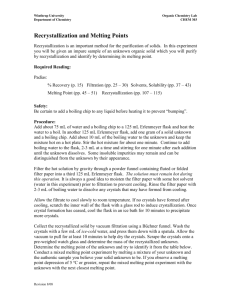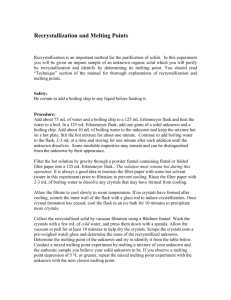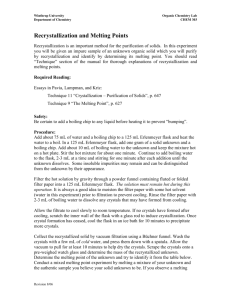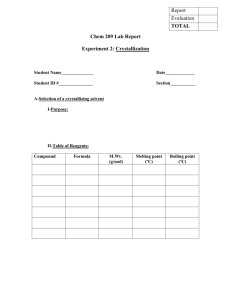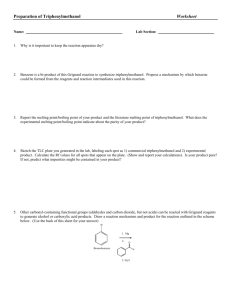Recrystallization(WU) - Rev 10-08
advertisement
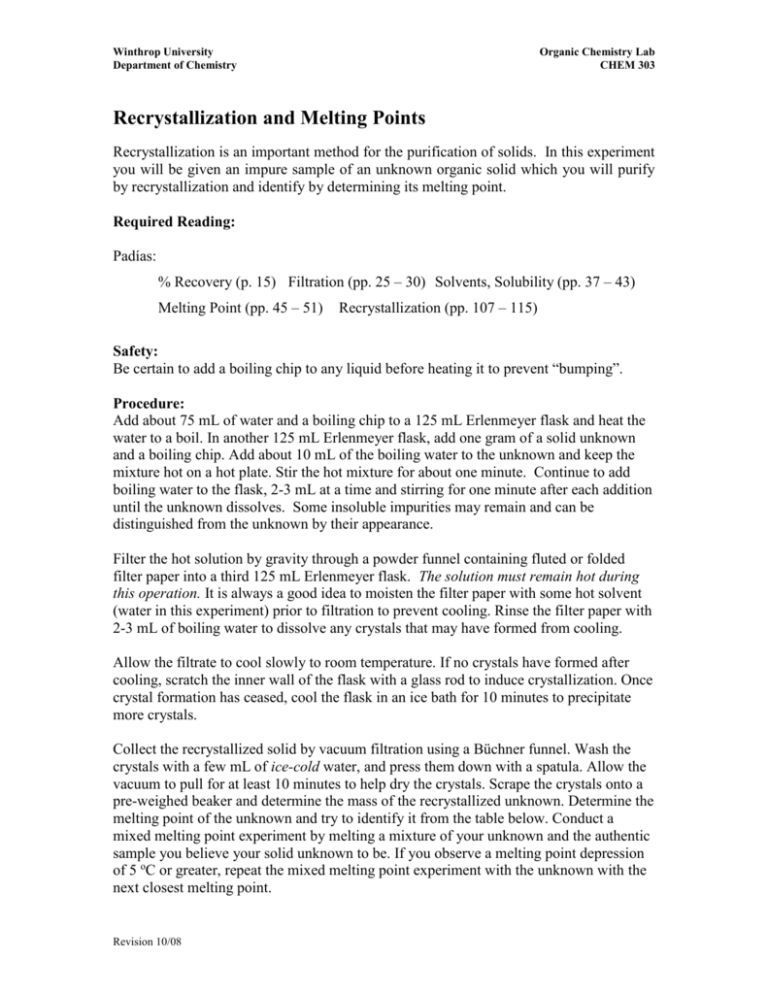
Winthrop University Department of Chemistry Organic Chemistry Lab CHEM 303 Recrystallization and Melting Points Recrystallization is an important method for the purification of solids. In this experiment you will be given an impure sample of an unknown organic solid which you will purify by recrystallization and identify by determining its melting point. Required Reading: Padías: % Recovery (p. 15) Filtration (pp. 25 – 30) Solvents, Solubility (pp. 37 – 43) Melting Point (pp. 45 – 51) Recrystallization (pp. 107 – 115) Safety: Be certain to add a boiling chip to any liquid before heating it to prevent “bumping”. Procedure: Add about 75 mL of water and a boiling chip to a 125 mL Erlenmeyer flask and heat the water to a boil. In another 125 mL Erlenmeyer flask, add one gram of a solid unknown and a boiling chip. Add about 10 mL of the boiling water to the unknown and keep the mixture hot on a hot plate. Stir the hot mixture for about one minute. Continue to add boiling water to the flask, 2-3 mL at a time and stirring for one minute after each addition until the unknown dissolves. Some insoluble impurities may remain and can be distinguished from the unknown by their appearance. Filter the hot solution by gravity through a powder funnel containing fluted or folded filter paper into a third 125 mL Erlenmeyer flask. The solution must remain hot during this operation. It is always a good idea to moisten the filter paper with some hot solvent (water in this experiment) prior to filtration to prevent cooling. Rinse the filter paper with 2-3 mL of boiling water to dissolve any crystals that may have formed from cooling. Allow the filtrate to cool slowly to room temperature. If no crystals have formed after cooling, scratch the inner wall of the flask with a glass rod to induce crystallization. Once crystal formation has ceased, cool the flask in an ice bath for 10 minutes to precipitate more crystals. Collect the recrystallized solid by vacuum filtration using a Büchner funnel. Wash the crystals with a few mL of ice-cold water, and press them down with a spatula. Allow the vacuum to pull for at least 10 minutes to help dry the crystals. Scrape the crystals onto a pre-weighed beaker and determine the mass of the recrystallized unknown. Determine the melting point of the unknown and try to identify it from the table below. Conduct a mixed melting point experiment by melting a mixture of your unknown and the authentic sample you believe your solid unknown to be. If you observe a melting point depression of 5 oC or greater, repeat the mixed melting point experiment with the unknown with the next closest melting point. Revision 10/08 Winthrop University Department of Chemistry Organic Chemistry Lab CHEM 303 Possible Recrystallization Unknowns Compound mp (oC) o-toluic acid m-toluic acid benzoic acid trans-cinnamic acid m-nitrobenzoic acid salicylic acid 103-105 108-112 122-123 131-136 140-142 158-161 Lab report: Your report should include the identity and structure of your unknown and a discussion on how you determined it. Calculate the percent recovery of your unknown. Questions: 1. Why is the product collected after recrystallization washed with cold solvent rather than hot solvent? 2. Three test tubes, labeled A, B, and C, contain compounds with approximately the same melting point. Using only a melting point apparatus, how could you prove that the test tubes contain three different chemical compounds? 3. Table sugar (sucrose) is refined on a large scale by recrystallization. What volume of boiling water (in mL) is required to dissolve 100 g of sucrose? If the solution were then cooled to room temperature (~20 °C), how much sucrose (in g) would recrystallize out of the solution? Revision 10/08
